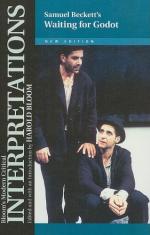|
This section contains 8,555 words (approx. 29 pages at 300 words per page) |

|
SOURCE: Mehta, Xerxes. “Shapes of Suffering: Image/Narrative/Impromptu in Beckett's Ohio Impromptu.” Journal of Beckett Studies 6, no. 1 (autumn 1996): 97-118.
In the following essay, Mehta examines Ohio Impromptu as a modernist interpretation of the classic theatrical impromptu form.
Beckett called his play an impromptu.1 An impromptu in the theatre is a quite specific form in which the playwright—usually through the vehicle of a play within a play—attacks his critics, defends his practice, and, traditionally, lets his audience in on a few of the tricks and all of the tribulations of his profession. Molière's L'Impromptu de Versailles, for example, lays before us what appears to be a rather chaotic attempt to put together a play for Louis XIV. The performance is at hand, the play isn't written yet, the playwright's in extreme anxiety, and his actors not only reject their assignments but pelt their leader with...
|
This section contains 8,555 words (approx. 29 pages at 300 words per page) |

|


